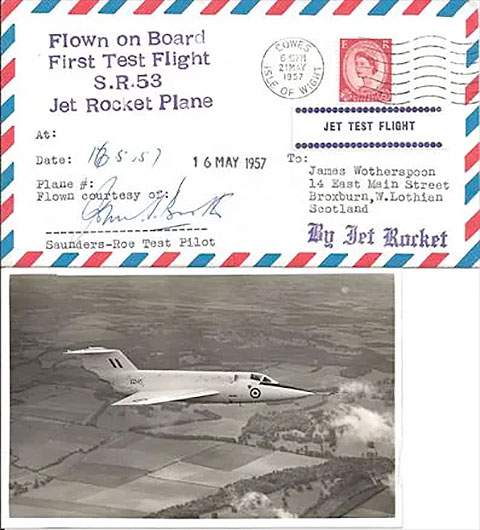Space Cover #124: SR. 53 Rocketplane The United States was not the only country developing rocket powered aircraft after World War II. The United Kingdom's Air Ministry drafted an Operational Requirement (O.R.) 301 in May 1951 for a rocket-powered interceptor that could reach an altitude of 60,000 ft (18,300 m) in just 2 minutes 30 seconds. The requirements of O.R. 301 began with the plane using a ramp launch and landing on a skid. This complicated the design so much that O.R. 31 was eventually amended to allow for a mixed engine configuration and a conventional plane undercarriage.
Two companies were selected for development contracts, A.V. Roe (Avro 720) and Saunders-Roe (SR.53). The Avro 720 development was ultimately cancelled as it neared its maiden flight. Meanwhile, the SR.53 aircraft's design had a sharply pointed nose, delta-like wings, and a T-tail. The Armstrong Siddeley Viper jet engine and de Havilland Spectre rocket engine and their exhausts were mounted one atop the other in the tail. The SR. 53 used hydrogen peroxide as its oxidiser instead of liguid oxygen.
The complexity of the SR. 53's design caused a series of setbacks, including an explosion occurring during ground tests of the Spectre rocket engine. The setbacks caused a delay to the SR. 53 first prototype - the XD145 - maiden flight. Finally, on May 16, 1957, Squadron Leader John S. Booth DFC (Distinguished Flying Cross) was at the controls of XD145 for the first test flight, following up with the maiden flight of the second prototype XD151, on December 6, 1957. Both flights were sucessful and pilots reported easiness of flying the plane. The two prototypes flew a total of 56 test flights, obtaining speeds of Mach 1.33.
While testing at RAE Boscombe Down, XD151 crashed on June 5, 1958 during an aborted takeoff on its 12th flight - while running off the runway the XD151 aircraft struck a concrete approach light causing it to explode on impact and killing its pilot, Squadron Leader Booth. The remaining prototype continued to fly with Lt Cdr Peter Lamb taking over the flight test program.
In 1957 the British government's announced its policy to largely abandon piloted aircraft in favor of concentrating on missile development. Also, jet engine development had progressed significantly in the six years since the SR.53's initial design. Combined with the fact that improvements in radar had meant that any incoming bomber threat could be detected much earlier, the need for an aircraft like the SR.53 had disappeared, and the project was cancelled on July 29, 1960.
This cover was flown aboard the first flight of the SR. 53 courtesy of Squadron Leader Booth. A total of 10 covers were flown on the first flight.













